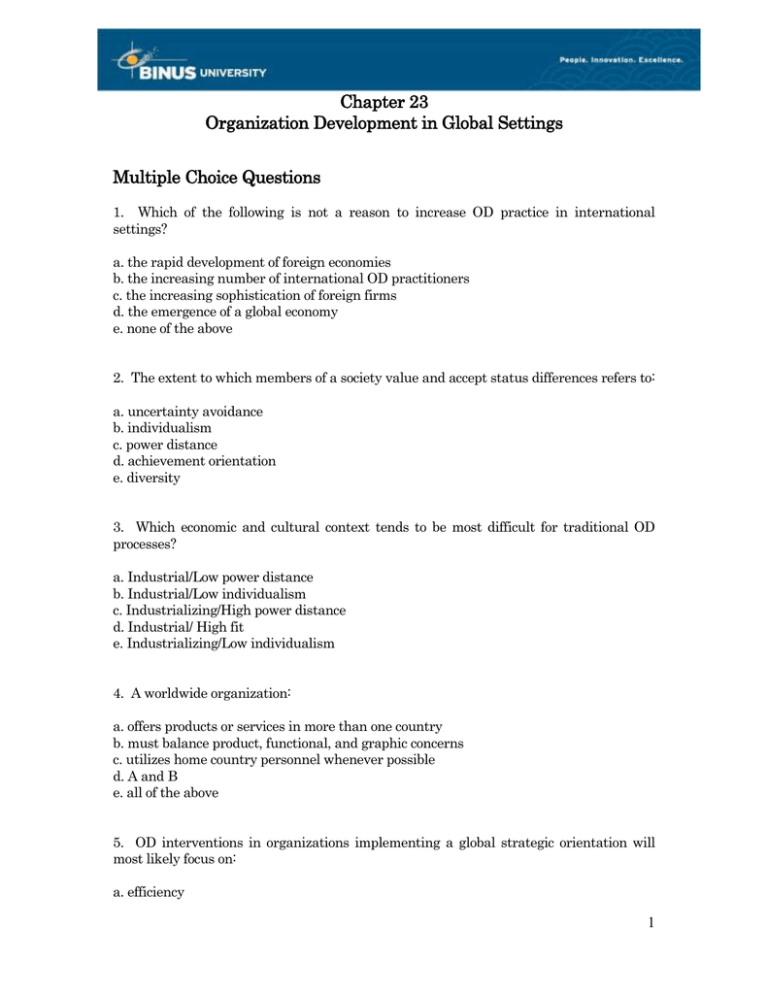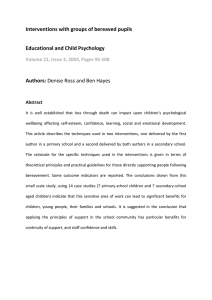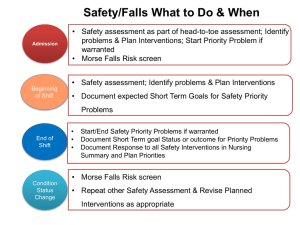OD in Global Settings: Chapter Questions
advertisement

Chapter 23 Organization Development in Global Settings Multiple Choice Questions 1. Which of the following is not a reason to increase OD practice in international settings? a. the rapid development of foreign economies b. the increasing number of international OD practitioners c. the increasing sophistication of foreign firms d. the emergence of a global economy e. none of the above 2. The extent to which members of a society value and accept status differences refers to: a. uncertainty avoidance b. individualism c. power distance d. achievement orientation e. diversity 3. Which economic and cultural context tends to be most difficult for traditional OD processes? a. Industrial/Low power distance b. Industrial/Low individualism c. Industrializing/High power distance d. Industrial/ High fit e. Industrializing/Low individualism 4. A worldwide organization: a. offers products or services in more than one country b. must balance product, functional, and graphic concerns c. utilizes home country personnel whenever possible d. A and B e. all of the above 5. OD interventions in organizations implementing a global strategic orientation will most likely focus on: a. efficiency 1 b. interpersonal relationships between the parent country and the subsidiary officer c. decentralizing decision making policies d. clarifying geocentric personnel policies 6. Which of the following is not a worldwide strategic orientation? a. Global b. Multinational c. Transitional d. International e. none of the above 7. A regiocentric personnel selection and recruitment policy is most likely to be associated with what type of strategic orientation? a. Global b. Multinational c. International d. Transnational e. Worldwide 8. Changing to a transnational strategic orientation typically involves: a. gaining the ability to coordinate operations on a worldwide basis b. centralizing structures c. standardizing products d. ethnocentric staffing 9. Which of the following activities are associated with OD in global social change organizations? a. b. c. d. e. changing the values of the local organization developing vertical linkages building horizontal linkages B and C all of the above 10. Unlike more traditional organizations, global social change organizations tend to: a. be more focused on profit b. more concerned with environmental change c. less politically oriented d. more concerned with internal efficiencies 2 True/False Questions 11. Many of the traditional OD interventions can be used to help organizations operating in foreign cultures. 12. OD interventions implemented under traditional OD assumptions are most likely to work well in industrialized economies with values that fit with traditional OD assumptions. 13. OD interventions that improve local subsidiary effectiveness are more likely to support a global strategic orientation. 14. All worldwide organizations eventually evolve toward a transitional strategic orientation. 15. Global social change organizations tend to be dominated by a strong set of normative values and beliefs. 16. Change agents working in global social change organizations need to possess good networking skills Essay Questions 18. Describe how OD interventions need to be adapted to fit different cultural contexts. 19. Pick one of the worldwide strategic orientations and describe how OD can improve the implementation of that strategy. 20. How do global social change organizations differ from traditional organizations? 3





